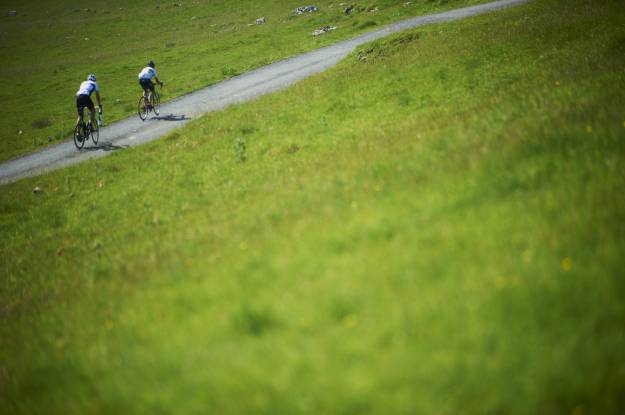Sunglasses aren’t just necessary during the summer months; eyewear should be an essential part of your cycling wardrobe throughout the year. The primary reason for wearing glasses on the bike is to protect your eyes. Insects, grit, animal muck and mud can all cause irritation or damage to your eyes which can lead to nasty infections.
Fit
Fit is vital. Glasses have to be comfortable and must not bounce around at all when being worn whilst riding over bumpy roads. All of our faces are different so look for an adjustable nose bridge and arms that you can bend to fit your head and ears. Silicon grippers where the arms contact your head and ears can also make a big difference.
Try before you buy
Although online deals can be tempting, trying on a selection of glasses is the only way to get a good fit so try on a few of your friends’ pairs and pay a visit to your local bike shop. Once you have found a comfy pair, put them through the jumping up and down test! There should be no slipping or bouncing. Next, check how the lenses fit to your eye sockets. You are looking for a snug fit that doesn’t leave significant gaps for the wind to blast in through.
Don’t forget your helmet
When trying on sunglasses, take your helmet with you. The arms of the glasses should go outside of your ears-straps. This isn’t just a “cycling fashion” statement as it will allow your glasses to come off in the event of a crash and avoid possible damage to your eyes. Check that when you are leaning forwards, as though riding on your drops, that the frame of the glasses doesn’t obscure your field of vision. This is especially important if you will be using the glasses for time trials where your position can be quite extreme.
Fogging
Although you want the lenses to closely follow the contours of your face, you do want to ensure that there is some airflow around the lenses or, especially when you come to a halt, the lenses may suffer from fogging. Look for lenses with venting slits and/or anti-fog coating.
Lenses
Interchangeable lenses massively increase the versatility of a pair of cycling sunglasses. Three different lenses should cover most eventualities. You will need some dark smoked or mirrored lenses that have a high UV protection rating for those rare bright and sunny days. Next up are some clear lenses for night riding or extremely overcast conditions. Finally, and the lenses you will probably get most use out of, are some red or yellow light enhancing lenses for those typically British in-between days. As well as brightening up even the foulest day, they increase object definition, which is particularly useful on rough country roads and if riding off-road. Your other option can also be photochromic lenses. For those of you, who don’t know, those lenses are light – adaptive. Which means the brighter light, the darker lenses, so you don’t have to take 3 different lenses with you.
How much to spend
If you go for one of the brands sported by the pros, you could easily be looking at £200 plus by the time you have factored in additional lenses. However, before spending this much, think of the life your glasses are going to live. Taken on and off roughly while on the bike, jammed into the vents of your helmet, shoved in a jersey pocket or carelessly flung on the seat of your car at the end of a tough event. It might be wiser to view cycling sunglasses as having a short life span and to opt for a less fashionable brand from whom you can get a decent pair of glasses with three lenses for under £50.00. Don’t be tempted by counterfeit versions of more expensive brands. Not only will you be supporting an illegal industry but they are unlikely to have been crash tested or have certified optics that will protect you from UV rays.
Prescription
If you require prescription lenses, you have a number of options. The easiest, if you get on with them, is to use contact lenses. Even if you don’t wear contact lenses the whole time, you could get a supply of disposable lenses just for cycling. Prescription main lenses can be very expensive, limit you to brands and models and reduce your choice of lenses. Also, remember what we said about the hard life that your cycling glasses are likely to lead. Some manufacturers produce glasses that a secondary pair of prescription lenses sit behind. This does give you lens changing flexibility but again makes and models are limited and it can be tricky to find ones that fit correctly. Some of you could also need reading glasses. In this case your good option can be lenses with bottom reading area, so you can read your equipment, like smart watch. Find more informations here: https://bbbcycling.com/uk_en/bsg-59ph-impress-reader-ph.











